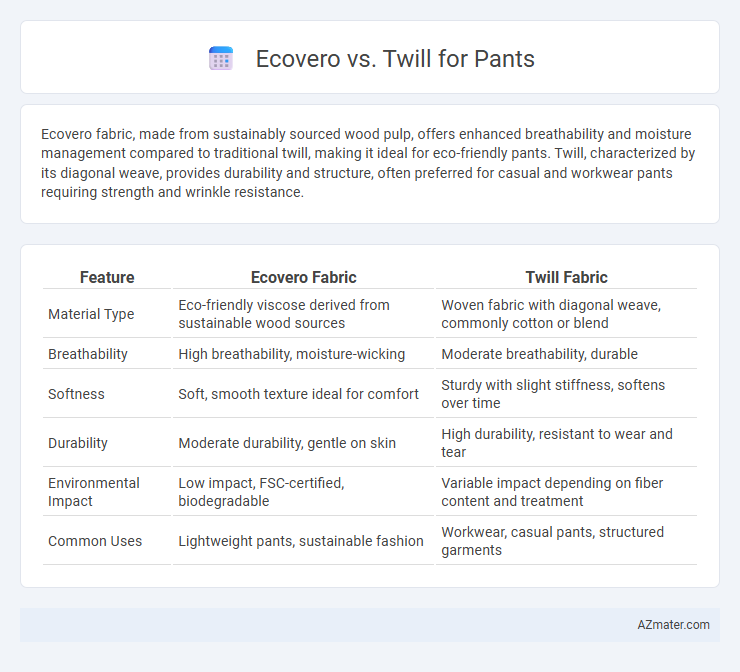Ecovero fabric, made from sustainably sourced wood pulp, offers enhanced breathability and moisture management compared to traditional twill, making it ideal for eco-friendly pants. Twill, characterized by its diagonal weave, provides durability and structure, often preferred for casual and workwear pants requiring strength and wrinkle resistance.
Table of Comparison
| Feature | Ecovero Fabric | Twill Fabric |
|---|---|---|
| Material Type | Eco-friendly viscose derived from sustainable wood sources | Woven fabric with diagonal weave, commonly cotton or blend |
| Breathability | High breathability, moisture-wicking | Moderate breathability, durable |
| Softness | Soft, smooth texture ideal for comfort | Sturdy with slight stiffness, softens over time |
| Durability | Moderate durability, gentle on skin | High durability, resistant to wear and tear |
| Environmental Impact | Low impact, FSC-certified, biodegradable | Variable impact depending on fiber content and treatment |
| Common Uses | Lightweight pants, sustainable fashion | Workwear, casual pants, structured garments |
Introduction to Sustainable Fabrics: Ecovero and Twill
Ecovero is a sustainable fabric made from certified wood pulp using environmentally responsible processes that reduce water and emissions compared to traditional viscose. Twill, characterized by its distinctive diagonal weave, can be produced using sustainable fibers like organic cotton or recycled materials, enhancing durability and eco-friendliness. Both fabrics offer sustainable options for pants, with Ecovero emphasizing eco-conscious fiber sourcing and Twill providing structural strength from renewable fibers.
What is Ecovero? Key Features and Benefits
Ecovero is a sustainable viscose fiber produced from certified renewable wood sources, designed to reduce environmental impact compared to conventional viscose. Key features include lower carbon emissions, reduced water usage, and a transparency-certified supply chain, making it an eco-friendly choice for textile manufacturing. Benefits of Ecovero fibers include softness, breathability, color vibrancy, and compliance with stringent sustainability standards, promoting responsible fashion and reducing ecological footprints.
Understanding Twill: Composition and Characteristics
Twill fabric for pants typically features a distinctive diagonal weave pattern that enhances durability and resistance to wear, making it ideal for workwear and casual trousers. Composed mainly of cotton or cotton blends, twill offers a soft yet strong texture with excellent breathability and comfort. Ecovero, a sustainable viscose fiber, contrasts with twill by being eco-friendly and made from certified renewable wood sources, but lacks the robust weave structure that defines twill's characteristic durability.
Eco-Friendliness: Ecovero vs Twill
Ecovero fibers, derived from sustainably sourced wood pulp, offer a biodegradable and low-impact alternative to conventional viscose, reducing water consumption by up to 50% and emitting fewer greenhouse gases during production. Twill fabric, typically made from cotton, polyester, or blends, varies in eco-friendliness depending on its fiber content and manufacturing practices, with sustainable versions using organic cotton or recycled fibers to minimize environmental harm. Comparing Ecovero and Twill for pants, Ecovero stands out for its certified eco-friendly attributes and closed-loop production, while Twill's sustainability largely depends on the source and treatment of its constituent fibers.
Comfort and Wearability Comparison
Ecovero fabric offers superior breathability and moisture-wicking properties, enhancing comfort for all-day wear in pants. Twill fabric, known for its durability and structured feel, provides excellent wearability but may retain more heat and feel heavier. Choosing between Ecovero and Twill depends on prioritizing lightweight comfort versus long-lasting toughness in pant materials.
Durability and Longevity of Ecovero and Twill Pants
Ecovero pants offer superior durability due to their eco-friendly viscose fibers derived from sustainable wood sources, which maintain fabric integrity through multiple washes. Twill pants are known for their tightly woven diagonal weave, providing exceptional strength and resistance to wear, making them ideal for heavy-use environments. Both fabrics ensure longevity, but Ecovero's sustainability benefits align with long-term durability, while twill's robust construction excels in abrasion resistance and structural stability.
Style and Versatility: Which Fabric Looks Better?
Ecovero fabric offers a soft, smooth texture with a natural matte finish that highlights a refined, elegant style ideal for lightweight, breathable pants. Twill fabric boasts a distinctive diagonal weave, creating a more structured, durable look that enhances casual and formal pant styles with excellent versatility. While Ecovero excels in sophistication and eco-friendly appeal, Twill provides robust wearability and a sharper visual texture, making it preferable for diverse styling options.
Care and Maintenance: Ecovero vs Twill
Ecovero fabric offers sustainable care benefits due to its moisture-wicking and quick-drying properties, making pants easier to maintain with less frequent washing and lower energy consumption during laundering. Twill pants, known for their durable weave, require gentle washing to preserve fabric integrity and prevent fading, often benefiting from cold water cycles and air drying to extend garment life. Both fabrics demand specific care routines, but Ecovero's eco-friendly fiber composition supports low-impact maintenance, while Twill's robustness ensures longevity with proper handling.
Price and Affordability Analysis
Ecovero fabric generally commands a higher price point due to its sustainable production process using certified renewable wood sources, making pants crafted from Ecovero more expensive but environmentally friendly. Twill fabric offers a more budget-friendly option, with affordability driven by its widespread availability and traditional manufacturing methods, often resulting in lower-cost pants suitable for everyday wear. Price-conscious consumers seeking durable trousers may prefer Twill, while those prioritizing eco-conscious fashion often invest in pricier Ecovero pants.
Which Fabric is Best for Pants: Ecovero or Twill?
Ecovero, made from sustainable viscose fibers derived from wood pulp, offers breathability and softness, making it ideal for comfortable and eco-friendly pants. Twill fabric, characterized by its distinct diagonal weave, provides durability, structure, and resistance to wrinkles and wear, making it perfect for tailored or work pants. Choosing between Ecovero and Twill depends on whether sustainability and comfort or durability and structure are the priority for your pants.

Infographic: Ecovero vs Twill for Pant
 azmater.com
azmater.com